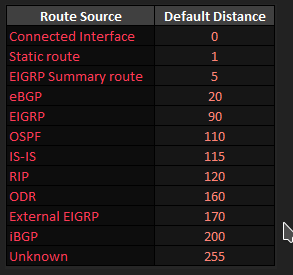3.3.d Implement, optimize, and troubleshoot administrative distance
This table should be memorized:

You should know how to change the AD of static routes, RIP, EIGRP, OSPF, BGP
Refer to the flash cards for lab scenarios.
1. Changing the AD of a static route
conf t ip route x.x.x.x x.x.x.x x.x.x.x <administrative distance> #The default is 1 Router(config)#ip route 8.8.8.8 255.255.255.255 192.168.1.2 249

2. RIP
conf t router rip distance <administrative distance>
the default is 120
note this only changes the AD that you send

3. EIGRP
conf t eigrp <AS> distance eigrp <internal> <external>
default for internal is 90, external is 170

For EIGRP you can also change the AD for specific neighbors, and even networks from the neighbor for example here is how to do it for the neighbor of 10.0.0.1 and for the network of 172.16.1.0 255.255.255.0
en conf t access-list 10 permit 172.16.1.0 0.0.0.255 router eigrp 1 distance 5 10.0.0.1 0.0.0.0 10
4. OSPF
conf t router ospf <process ID> distance ospf <external | inter-area | intra-area> <AD>
default for all is 110

OSPF offers the same capability for changing a specific neighbors AD or for specific networks
just like the EIGRP example we can do this
en conf t access-list 10 permit 172.16.1.0 0.0.0.255 router ospf 1 distance 5 10.0.0.1 0.0.0.0 10
5. BGP
bgp ad can be changed under the address-family
en conf t router bgp <ASN> distance bgp <external> <internal> <local> distance <ad> <neighbor> <optional ACL>